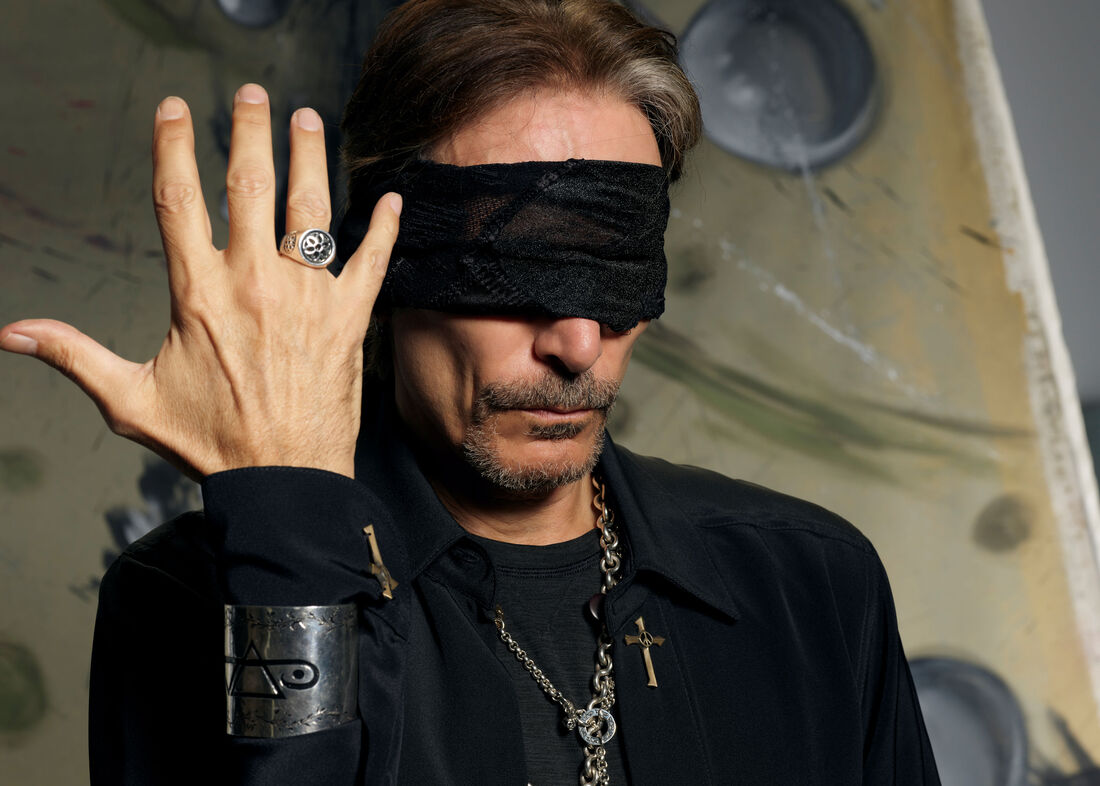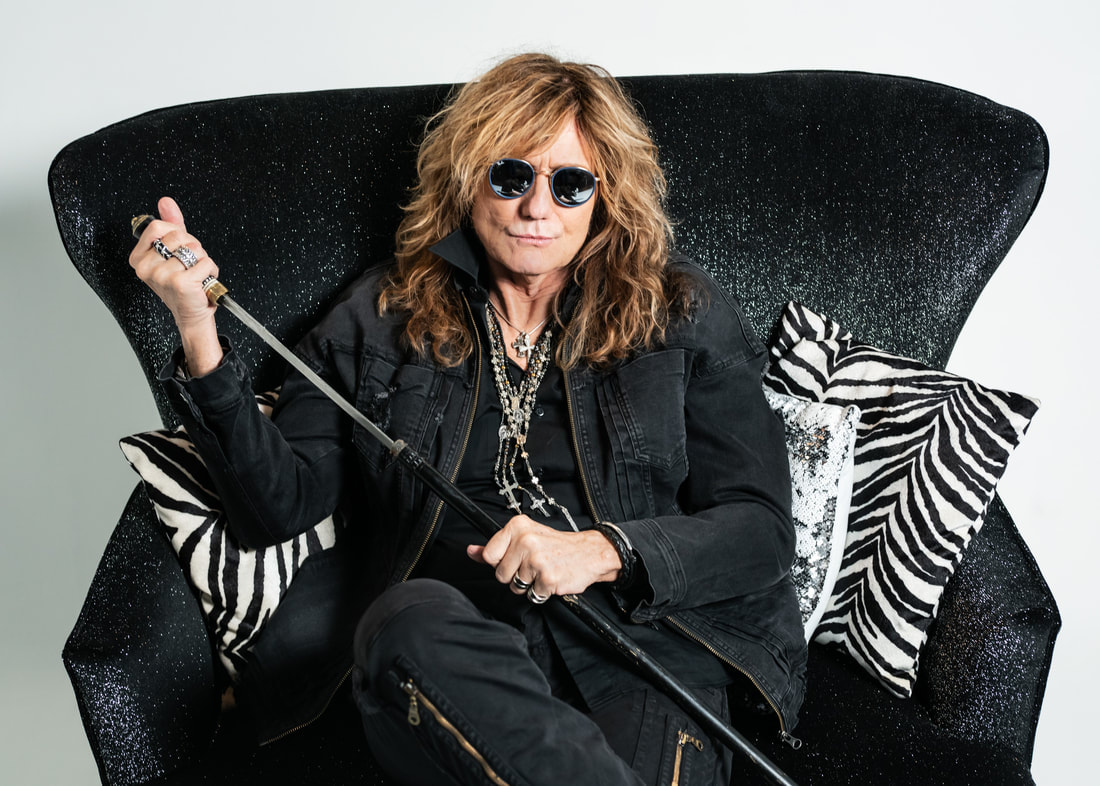|
Appropriately crowned “the master of the space age guitar” by Brian May at the Guitar Legends Expo in Seville back in 1991, with a career that had seen him do stints with Whitesnake and both David Lee Roth and Frank Zappa, even by then, Steve Vai’s status was assured. With a celebrated solo career, benchmark albums and numerous collaborations since, the New Yorker has gone on to solidify his reputation as the guitarist's guitarist, and then some. We sat down with Steve for a chat about new album ‘Inviolate’, his continued instrumental innovation, and touch on some of his past work. Greasy kids stuff; Eamon O’Neill.
Hi Steve, how are you today?
I’m doing fantastic. It’s beautiful here in sunny Southern California, and yeah, I’m doing good. Congratulations on the new album. To these ears, it has echoes of both ‘Passion and Warfare’ [1990], and ‘Fire Garden’ [1996]; were you thinking about a little bit of your past going into it? Well, you always take your past with you, creatively, and you gain new stuff as you go. It's always that way for everybody. You never go backwards; you can’t. It’s an illusion if you believe you’re going backwards. I just so much enjoy my job, just thinking up crazy things and then bringing them into the world, musically. I just love doing that, and my experience through the pandemic was not so different to a lot of musicians, in that I was working on stuff, I had stuff planned, and it immediately had to be altered, which was fine, because if it’s not one thing, it’s six others! So you had plenty going on, as the lockdowns took hold? You can never be bored if you just look around and stay creative, so when the lockdown came, many musicians were starting to put content out online, and I started doing that. I did some series’ under it all, and ‘Alien Guitar Secrets’, but it also gave me some time to fool around with some guitar stuff I had wanted to do but I didn’t really have time. So, the first thing I did was a song called ‘Candlepower’, which led to ‘Inviolate’. There were some challenging kind of tongue-twisters in that, so that took a while! But, I released that in a video, and people enjoyed it; my fans enjoyed it. That’s when you started thinking about a new album? So then I thought I would release a solo acoustic vocal version of a song called ‘The Moon and I’, so it was just live in the studio, me playing acoustic guitar and singing, which you’ve never really seen before. I’ve never done it, and I enjoyed doing it, and I always had the idea to do a solo acoustic vocal record, and when I launched ‘The Moon and I’, there was such a nice response from it, I though; “maybe now’s the time! I’m in Lockdown”! I had all these songs for many years that I just started to record, solo. Nothing virtuosic; it’s just songs, and I got about three quarters of the way through it, and then my shoulder kind of gave out and my finger gave out, and that was a year ago. You’re talking about the injuries that you sustained that led to surgery. I had to get surgery. I’m a holistic guy, and I never get sick really, and I’m really a happy, healthy guy, but you know, fifty years of playing the guitar like this; something happened! That actually led to an innovation though, in ‘Knappsack’, which you played one-handed. Well, when I did that, I got out of the hospital and I was wearing a knapsack – that was the name of the thing – and I only had one hand. But I had just received one of the new Black Onyx PIA’s [signature Ibanez guitar], so here I am with my arm in a sling, and as soon as I put my hands on the guitar, I started playing that. I mean, it’s not hard to play with one hand if you’re the kind of player that I am with legato and hammers and stuff like that. So, the moment I did that, I just said; “I know what I’m going to do. I’m going to record a song with one hand”, because I knew I could do it. Also, I thought other people would get a kick out of it, but when I started to do it, I gave myself some directives, and one of them was; it’s got to sound like an enjoyable piece of music with a good melody, and it has to stand on its own, and it can’t sound like a gimmick. You didn’t want the one-hand thing to be a novelty. You’ve got to avoid the gimmick so people that hear the song don’t even know it’s being played with one hand, and if you like that kind of music, it’s just an enjoyable piece of music, but then when you watch it, you’re like; “oh!”. The album kicks off with ‘Teeth of the Hydra’, which is basically, the quintessential Vai sound.
Well, the ‘Teeth of the Hydra’ came along and it was just like an instant inspiration. All the good stuff comes to us in like a download; like the whole idea is there. Basically, if I was to explain what that inspiration sounded like, it would take much longer to explain it, because it was instant. What it was, was, basically, I like multi-neck guitars, and I’ve had them in the past, but I never really felt like I integrated them, all of the strings and everything into a real piece of music. I did a little bit with ‘Fever Dream’ on ‘The Ultra Zone’ [1999] with the big heart guitar, but still. So I thought; “I’m going to make a guitar that’s got a twelve-string neck that’s half fretless; seven string, ¾ inch bass neck, and these thirteen harp strings”, and I was really into steampunk fashion at that time – this is like five years ago – so I got all this material together and I sent it to Hoshino [Gakki, owner of Ibanez guitars]. You’re talking about the birth of the stunning ‘Hydra’ guitar, that you can be seen wearing on the album’s sleeve. Yeah, and the designers just went crazy! They got big wood! They sent me this rendering, and it was amazing. Then for a couple of years we just started to work on it, and they’d come over with big pieces of cardboard and stuff, and we’d feel it out and make changes, and finally they made a prototype. I actually have a prototype Hydra, and that was good because then we said; “okay, let’s change this”, and a lot of work went into it, and when I finally got it, I could not believe what they did. I just couldn’t believe they built this thing. And it had so much more; they had a whole guitar synthesizer section, the sample and hold features, sustainers; it’s a very, highly-technical instrument, and it’s a one-off. Some people think that this is available as a signature guitar, but no, it’s like, incredibly expensive. It sounds like, to play it properly, you’d almost have to learn how to play guitar again. Yeah, you kind of do. Did you see the video, the ‘Hydra reveal’ [see below]? The NFT of it is going to be auctioned. I want to keep it, at least for the next few tours, you know?! It joins a long list of unique guitars that you’ve owned, such as the flame-shaped one from the David Lee Roth ‘Goin’ Crazy!’ video, and of course the ‘Ultra Zone’ model which was designed by an Irishman. The flame guitar is one of the ones that I don’t have anymore, and that’s because my friend Joe Despagni - who was my best friend since childhood - he made it for me, and he passed away several years ago, but towards the end, he was having a little financial problems, so I sold that guitar. I can’t believe how much money I got for it, and I gave the money to him, because he built it, and that’s why I sold it. But the other ones I have. Alistair Hay, who made ‘The Ultra Zone’ guitar, I have that, and I’m looking at it now! But I’ve promised that to him. The Hydra, I don’t know what will become of it. So once you had the Hydra guitar, you decided you had to write a song with it. When I got the guitar, I had to figure out how to write a piece of music with it, and the same thing as ‘Knappsack’, I gave myself some directives, and the first directive was; “this has to stand on its own as a piece of enjoyable music; it cant sound like a gimmick, it can’t sound compromised by the guitar”. So that was quite a challenge because when you listen to the song, all the bass, twelve-string, and seven-string and harp-string; it’s all one performance on the Hydra. So, there’s so much technical information in this guitar, we wanted to do a really good documentation of it, so we hired this great company to make that Hydra reveal video. The funny thing is, I was looking at that, and there was definitely some funny comments! I don’t think people really understand when they hear the song, what’s actually happening. As a guitarist, you’re in a unique club along with the likes of Uli Jon Roth, who are really evolving what the instrument actually is.
Well, Uli only had to do it once because that Sky guitar is a magnificent piece of art. That guitar, that Sky guitar that he designed, it’s underrated. People don’t know the significance of it. But I’ve designed guitars, interestingly enough, like the JEM, just based on very innocent desires. When I designed the JEM, I had no expectation that anybody else would be interested in it, you know, but I knew that I wanted certain frets, and this kind of thing, and certain pickup configurations, and it was a shocker that the guitar went on to be the best-selling signature guitar. Surely one of your greatest legacies outside of your catalogue is the creation of the seven string guitar; you basically created the nu metal genre! Yeah, it was nice. It was really nice because when we did the first seven string, I knew that there was going to be these young players that were going to come along and see the potential of that low string and just start pumping away on it, and sure enough they did, and they created that whole subculture. A lot of people don’t know my contribution. I do interviews sometimes, and they say, “so Steve, with everybody playing a seven string now, do you think you’ll ever play one?” And I just think; “no, I don’t think so. If everybody’s doing it, why should I?!” One of the first songs people will have heard from the album is ‘Zeus in Chains’, which has a real Celtic feel in places. It has! Thank you for pointing that out! It’s very Celtic, especially [sings the main riff]. That’s so nice that you caught that, because I love Celtic music, and I’ve listened to it quite extensively through the years. When I was writing ‘Zeus in Chains’, I could have went [plays more straightforward version of the riff], but I wanted it to be Celtic. There’s a different bounce; that’s Celtic. There’s an interesting porridge in Celtic. It’s hard to explain, but it’s all Celtic. It is. I recognized that straight away. That’s great. That tickles me, to be honest because that’s what I was going for. I’m sitting there going to myself; “no, it’s got to be more Celtic!”, because it’s difficult. There’s a swing in Celtic music. It’s a cultural thing; it has to be in your DNA. You’ve successfully navigated those stylistic curveballs before though, such as on ‘The Blood & Tears’ from ‘The Ultra Zone’; you don’t fence yourself in as a rock guitarist, do you? Well, other people do that, you know? They do it to themselves. They say; “I do this, and I can’t venture out of this, because then I won’t be a part of the club”, and god forbid you’re excluded from a club. I’ve just unfortunately - well, fortunately -never been able to really contain myself in one particular musical discipline because I just have different tastes. Like, if I conceive in my mind ‘Candlepower’, it had nothing to do with metal or anything like that. I’m not going to say; “well, I can’t do that song because I’m a metal guy”. So, those kinds of distinctions? I’m 61, I don’t make them anymore! You mentioned your acoustic playing earlier, and I wanted to touch on ‘Sisters’, which is one of the most beautiful tracks you’ve ever written.
‘Sisters’, I wrote that when I was in high school, and I played it through college, and I played it before I made [debut solo album] ‘Flex-Able’ [1984], but I always felt one day I’d love to record it. I felt that way, and I have a friend that - this was back when we were 20 years old - I had performed it at a little show I was doing, and she was weeping. Some people resonate with music a particular way – I’m not going to make everybody weep – but she says; “every time I hear that song, it just does something to me”, and I thought; “hmmm, well it does something to me too. There’s a beautiful little energy in it”. Do you remember recording it? When it came time to record ‘Passion and Warfare’ – this is maybe an interesting story – so I’m 25 or 26, and ‘Passion and Warfare’ is back here [in the back of my head] and it’s just going “let me out! Let me out!”, and I started recording it even when I was with all these other bands. It [the album] was a little secret. I didn’t expect that record to sell, I didn’t expect anything; I just wanted to make it. And when it came time to fill the slot on the record where I wanted a piece like ‘Sisters’, I almost thought – and this was a big education for me - I used to think that it had to be technically dazzling in order to be interesting, or in order for it to be engaging. Now, that is true, there is a certain engagement that we have with fascinating looking things performed, and I love that, I love to be able to play fascinatingly, but have it be accessible, musically. There’s nothing fascinating about the performance of ‘Sisters’; it’s very simple, right? So, I was going back and forth in my mind; “well this is very simple; are people going to like it?!” That’s kind of where I was at back then, but I loved it so much that I just said; “I’m just going to record this piece. I really want to do it. People might not get it; it might be a song they skip over”, and boy, was I wrong! It's reminiscent of ‘Damn Good’ form David Lee Roth’s ‘Skyscraper’ [1988] album, with those sliding nuances and harmonics. You can kind of hear it, yeah. To be honest, ‘Damn Good’ was originally called ‘Scandinavian Air Solo’. That’s what I called It when I wrote it, and that was scheduled for ‘Passion and Warfare’, but since we did ‘Damn Good’, I didn’t do it for ‘Passion and Warfare’. Speaking of David Lee Roth, with his final dates originally scheduled for January, was there a chance you’d have shown up, even just to see the show?
Well, I was scheduled to be in rehearsals, but, yeah, I know that those were announced to be his last shows, and you know what, god bless him. David Lee Roth came, and he delivered, in a big way for all of us, and might I add, he changed the whole scene, in the world of ‘80s rock, and rock in general. I mean, he played the part; and was a bona fide rock star, and we loved it. I know for me, it was amazing because I got to be a part of that whole craziness, and it was so much fun. It made me famous almost overnight, so it was great. So, I’m very happy for him. I’m happy because your voice is not like your fingers; it changes, and it’s hard for singers. I think unless you’re Tony Bennet who’s just a miracle, or Tom Jones; I went to see that guy who’s 80 years old, even older, and he kicked everybody’s ass! It was amazing, really, the way this guy sang. When was the last time you played ‘Goin’ Crazy!’ on guitar? If someone said to you that you had to play it tonight, could you? I don’t know, let me see [picks up guitar]. I haven’t played it in decades! I forget what key it’s in [Starts playing riff]. Yeah, I can do it. How did it go now? [feels his way through the verse section] Oh, that’s right… something like that. But that was the first time I’ve played it in, I don’t know, thirty-five years?! Finally, tell us about the touring plans in support of ‘Inviolate’. So I have planned a mega tour. This mega tour is like over 250 shows around the world, and it’s going to take a year and a half. You know, I had that shoulder surgery a year ago and it healed great, and I made ‘Inviolate’, but over the summer I tore it again. It was a different thing, but this time I did something stupid, and I thought I could kind of get away with doing the first leg of the tour or maybe the whole tour, but it just got worse and worse, and the doctor said; “it’s not going to get better, it’s only going to get worse”. I’m a holistic kind of a guy, and I try to take the holistic approach, and that works for me, but this is something different, you know? A tear. So what does that mean for the tour? We’ve booked the tour in modules; there’s the US leg, there’s the European leg, Western European, there’s the Australian, Indonesian leg, there’s Russia, Eastern Europe, Japan, Southeast Asia; there’s all these legs because you never know what can happen. When I started to prepare, there was just no way, and I called the doctor and he said; “if you get fixed now, by the time your summer tour comes, you’ll be fine”. So, that’s what I’ve decided, because you cause more damage, and then it’s irreparable, and once it gets there; I can’t raise my arm more than this [a few inches] right now, and if I don’t get it fixed, I’ll never! It's best to rest; we need those arms to work! Well, luckily, I can still do all this [finger movements]! I could even play the Hydra, but I can’t lift, and I can’t really strum at my potential. But we’ll be seeing you soon on tour. Well, the summer in Europe. We haven’t announced that, but it’s booked, and then after that it’s this tour [postponed US leg] that I was supposed to do; and then after that it’s South America, and it just goes on and on. Like this interview? Like us on Facebook and follow us on Twitter for regular updates & more of the same. Steve Vai's 'Inviolate' is available now, via Mascot Label. |
|
STEVE VAI.
"I love to be able to play fascinatingly, but have it be accessible, musically."
© 2016 - 2024 eonmusic.co.ukContact: [email protected]
|




